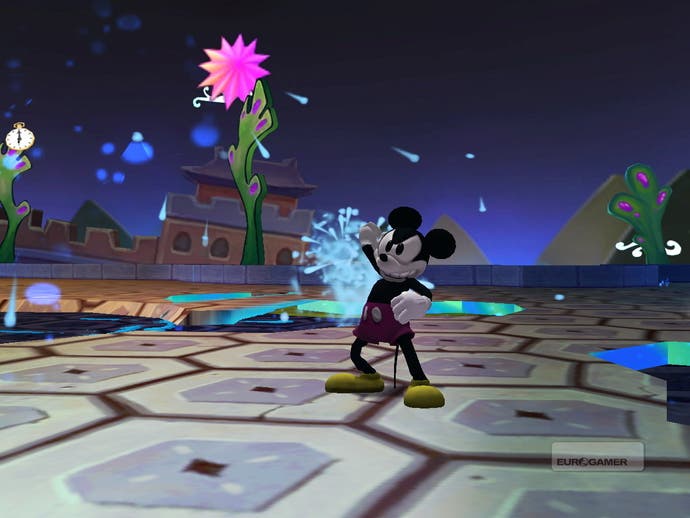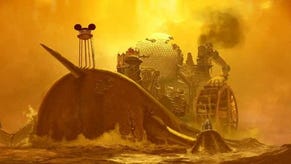Disney Epic Mickey
Retaking the Mickey.
The two directions you can take Mickey in - mischievous "scrapper" or virtuous "hero" - have their basis in his two main interactions with the game world via the paintbrush he carries with him. He can use paint and thinner to create or erase, restore or damage respectively; you do this by using the Wii remote to point where you want throw or apply them. The twisted, inert part of the Wasteland can't be affected, but everything else - made as it is out of ink and paint - can: platforms can be conjured out of thin air, obstacles removed, objects reshaped.
The element of choice doesn't stop there, because paint and thinner are both limited resources - you won't just have to choose which to use, but when to use it. And the consequences of your choice might be deeper than you think. For example, erasing a bookcase to get at what's behind it doesn't just remove the physical object from your world, it removes the information in the books.
Mickey evolves according to your preferred interactions; using more thinner increases his personal, destructive powers, and gives him a meaner demeanour, more dynamic animations. So does choosing to trade the scattered parts of the robot Donald Duck with a collector, rather than opting to rebuild him. Spector is a little more vague on the benefits of choosing a constructive path, but it seems to revolve around helping others - for example, the floating "gremlins" created by Disney and Roald Dahl in the forties for a film that never saw the light of day - to gain their help in return.
It will be possible, but hard, to change your path from scrapper to hero and back. Spector says he has experimented in the past with setting choices in stone, or alternatively giving the player complete freedom to change their style, and "neither really works".

There will always be multiple ways to solve any problem in Epic Mickey, with Spector going as far as to assert that you'll be able to get round all the game's bosses without fighting them, if you can simply figure out what they want. Nor will it always be a simple choice between paint and thinner, as other tools, or "sketches", come into play. Draw a television and it will distract any being in the game world; draw a watch, and it turns the world sepia and slows down time. These sketches, Spector says, are exploration tools in the Zelda mould, but can also create interesting emergent behaviours when used together.
We're taken through a demonstration showing multiple routes to a single level - its fractured, colourful 3D exploration strongly reminiscent of Super Mario Galaxy, if not quite as pretty or as head-spinning. (There will also be traditional 2D platforming levels, each taking direct inspiration from a specific, classic Mickey cartoon.) At one point, Mickey has to negotiate a large spinning fan, and we're shown three of a possible five solutions to this problem - he can use the watch to slow it down and step through, simply erase it, or free a gremlin elsewhere in the level who will help him to stop it.
It's Mickey's broad range of interactions with the rest of the game's cast, right down to its simplest enemies, that are the most exciting and unusual aspect of this exciting and unusual platformer. Dealing with other beings in ways that go beyond simple, physical slapstick is unusual in a cartoon game - in fact, it's unusual outside sandbox RPGs - but even the silly Spatters, blob-like minions of the Phantom Blot, can be distracted or befriended as well as erased.

Mickey will also encounter his old foes Black Pete ("a running gag and a formidable foe"), the Mad Doctor from the cartoon of the same name, and Oswald's children - a horde of baby bunnies who love Mickey "a little too much", mobbing him, slowing him down, directing him into danger and causing chaos when they meet the Spatters. Then there are the Beetleworx, sinister manifestations of the Wasteland's twisted, inert side, who are immune to both paint and thinner. How you deal with them remains a mystery - Spector will only say that it's "a different kind of challenge".
In motion, Epic Mickey looks lively and solid, a polished example of a licensed cartoon adventure - but not a whole lot more. Its aesthetic isn't as stark as the leaked concept art might have suggested, and its flexibility and depth aren't immediately apparent beneath the busy, colourful action.
But seeing the breadth of choice, the player's freedom of action demonstrated - and hearing Spector talk about it - does mark Epic Mickey out as a trailblazer. It's not that these things have never been attempted before in videogames, but they've never been attempted in a game like this, or with a character like this. That Disney is letting Spector take the all-ages platform game in this direction is remarkable enough. That it's letting him (and the player) have their way with its precious mascot is more remarkable still. That it's chosen videogames - in as interactive a form as they currently come - as the arena for Mickey Mouse's rebirth is the most thrilling risk of all.
The Walt Disney Company is an old dog too. Warren Spector might not be learning new tricks, but he's certainly teaching them.
Disney Epic Mickey is due out exclusively for Wii in autumn 2010.





.png?width=291&height=164&fit=crop&quality=80&format=jpg&auto=webp)



